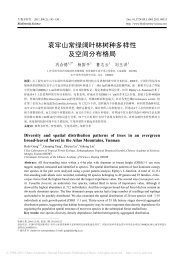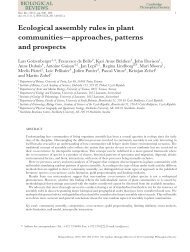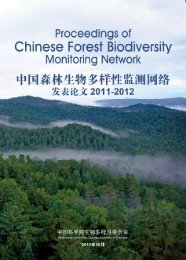the maintenance of species-richness in plant communities
the maintenance of species-richness in plant communities
the maintenance of species-richness in plant communities
Create successful ePaper yourself
Turn your PDF publications into a flip-book with our unique Google optimized e-Paper software.
Ma<strong>in</strong>tenance <strong>of</strong> <strong>species</strong>-<strong>richness</strong> <strong>in</strong> <strong>plant</strong> <strong>communities</strong> 123<br />
1960 1961 1964 1965 1966 1967 1960 1969 1970 1971<br />
Scaevo/a sp<strong>in</strong>escens 0. ..OOO..<br />
Acacia aneura 0 ~ O . ~ . , .<br />
Acacia pru<strong>in</strong>ocarpa<br />
0<br />
O....0.<br />
Acacia tetragonophylla 0 0 . 0 . O 0.<br />
Cassia desolata 0 0 . 0 0.0 0.<br />
Cassia helrnsii 0 . 0 0 . ~ ~ .<br />
Erernophila fraseri ..........<br />
Acacia victoriae O ~ O O ~ O O<br />
Hakea lorea 0 O o....o<br />
Santalum spicatum o OOO..OO<br />
0 0<br />
0 1-25 26-50<br />
51-75 76-100<br />
Fig. 7. The crops <strong>of</strong> fruit produced by ten <strong>species</strong> <strong>of</strong> trees and shrubs over 10 years <strong>in</strong> an arid<br />
region <strong>of</strong> Western Australia (from Davies, 1976). The results are expressed as percentages <strong>of</strong> <strong>the</strong><br />
best year’s production. Blanks <strong>in</strong>dicate that nu recoras were kept <strong>in</strong> those years. Reproduced<br />
from <strong>the</strong> Journal <strong>of</strong> Ecology with permission.<br />
<strong>in</strong> <strong>the</strong> U.S.S.R. and <strong>of</strong> Sarukhh & Harper (1973) for <strong>plant</strong>s <strong>in</strong> a Welsh pasture.<br />
There are also very few data for annuals, e.g. those <strong>of</strong> Newman (1964) for certa<strong>in</strong><br />
w<strong>in</strong>ter annuals <strong>in</strong> eastern England.<br />
In each <strong>of</strong> <strong>the</strong> forest <strong>communities</strong> that have been studied, three ma<strong>in</strong> patterns <strong>of</strong><br />
seed production have emerged: (a) moderate production <strong>in</strong> most years, (b) fruit<strong>in</strong>g<br />
ra<strong>the</strong>r irregular, and (c) abundant fruit<strong>in</strong>g strongly periodic (see Figs. 5 and 6). The<br />
same patterns have been found <strong>in</strong> a sample <strong>of</strong> <strong>species</strong> <strong>of</strong> semi-desert scrub (Fig. 7).<br />
Different <strong>species</strong> <strong>in</strong> group (b) are favoured by different years. It is important to<br />
realize that <strong>the</strong> variability <strong>in</strong> <strong>the</strong> supply <strong>of</strong> viable seed to different gaps will be greater<br />
than that suggested by <strong>the</strong> mean differences between <strong>species</strong>, not only because <strong>of</strong><br />
differences <strong>in</strong> dispersal, etc., but also because <strong>of</strong> differences between <strong>in</strong>dividuals <strong>of</strong><br />
each <strong>species</strong> - at least those <strong>in</strong> groups (a) and (b). In any one year some <strong>in</strong>dividuals<br />
fruit abundantly and o<strong>the</strong>rs less SO.<br />
It is virtually certa<strong>in</strong> that <strong>the</strong> three ma<strong>in</strong> patterns <strong>of</strong> seed production reflect three<br />
correspond<strong>in</strong>g patterns <strong>of</strong> flower<strong>in</strong>g, although <strong>the</strong>re is little published evidence to<br />
prove <strong>the</strong> po<strong>in</strong>t. The three patterns have been shown clearly <strong>in</strong> herbs <strong>in</strong> Europe<br />
(Fig. 8) and trees <strong>in</strong> Malaya (Medway, 1972). However, no exact correspondence<br />
between <strong>the</strong> numbers <strong>of</strong> flowers and <strong>of</strong> viable seeds can be expected because <strong>of</strong> wide<br />
variations <strong>in</strong> <strong>the</strong> success <strong>of</strong> poll<strong>in</strong>ation and <strong>the</strong> ‘sett<strong>in</strong>g’ or ripen<strong>in</strong>g <strong>of</strong> <strong>the</strong> seed.
















